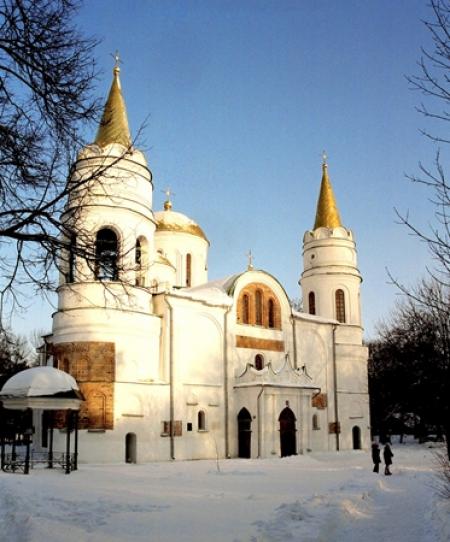 Spaso-Preobrazhens’kyi Cathedral is one of the most ancient temples of Ukraine-Rus’
Spaso-Preobrazhens’kyi Cathedral is one of the most ancient temples of Ukraine-Rus’.
It is situated in the historic area of Chernihiv, in the center of former Dytynets’ (Citadel). It was the main architectural dominant f the city. Thanks to high towers flanking the back façade it is still playing the role of an important dominant. Building of the cathedral started approximately in 1033-1034 by the order of first chronically-known Chernihiv prince Mstyslav Volodymyrovych. Chronicles first mention “the church of Holy Saviour” in 1036 when prince Mstyslav suddenly died. By that time the walls of the cathedral had been built as high as the equestrian standing in the stirrups with hands up (nearly 4 meters). Probably the building stopped after Mstyslav’s death and the cathedral was built up during the rule of the next Chernihiv prince – Svyatoslav Yaroslavych.
Our Saviour Cathedral was built according to Byzantium architectural traditions. Architectural experts call the planning-spatial decision unique as none of known Old Rus’ temples has suchlike construction. Byzantium cross-dome scheme is combined with elements of Roman basilica.
So-called mixed masonry (a combination of plinth and natural stone) which had been borrowed from Byzantium was used for building. The facades of the Cathedral are ornamented with tracery made of bricks during the brickwork – meanders, wickerwork, crosses. The combination of brick ornaments, plinth layer masonry and natural stone with wide stripes of mortar gave the facades of the Cathedral special solemnity and picturesqueness. A round tower was attached to the western façade from the northern side inside which a spiral staircase led to the gallery of the Cathedral. There prince with his closest entourage stayed during the liturgy. A wooden floor of the gallery burnt up during the fire in the middle of the 18th century and it has not been reconstructed ever since. After the temple had been built a baptistery (small one-dome church for the purpose of baptizing) was attached to the south-western corner of the temple (it has been ruined).
Special attention was paid to the inner ornamentation of the temple. In old times the interior was richer and more beautiful than today. Walls and vaults were decorated with fresco painting; the floor made of carved slate plates (pink slate) was ornamented with colourful mosaic. Today we can see fragments of old frescos, carved slate parapets of the gallery and massive columns which hide inside them the remains of original white-marble columns.
Nowadays the main attraction in the temple is a baroque iconostasis made in the end of the 18th century in the place of a previous one damaged by the fire of 1750. During the next repairs a damaged by fire baptistery was taken to pieces and a round in a foundation tower symmetrical to a northern one was built. Both towers were crowned with high steeples and the shape of domes was slightly changed. At the beginning of the 19th century big tambours were attached to the temple after which it got its modern look. The Cathedral has been princes’ burial vault since old times. In 1036 its founder prince Mstyslav Volodymyrovych was entombed there as well as his wife Anastasia and son Yevstaphiy. Princes Svyatoslav Yaroslavych, Hlib Svyatoslavych (1078), Oleh Svyatoslavych (1115) were buried there. In 1150 Svyatoslav Ol’hovych brought the relics of prince-monk Ihor Ol’hovych killed in 1147 and later canonized to Chernihiv Our Saviour Cathedral. The heroes of “The Song of Ihor's Campaign” princes Vsevolod Svyatoslavych and Yaroslav Vsevolodovych found their last shelter there. Written sources told us that up to 1572 the relics of Chernihiv prince Mykhailo killed in the Horde had been kept in the Cathedral before being taken to Moscow Kremlin. Since 1896 the Cathedral became the location of the relics of St. Theodosiy Chernihivs’kyi.

Our Saviour Cathedral has always been the main sanctuary of Chernihiv-Sivers’kyi land, its social-political center. In the times of Kyiv Rus’ treaties were signed and prince’s orders were announced here. In 1814 the standards of Chernihiv regiments which had participated in the war against Napoleon were set up there and in 1856 – the standards that had glorified in the battles of the Crimean war 1853-1856. The temple was so honoured, that all monarchs and Emperor’s family members who visited Chernihiv certainly visited it not saying about different high priests and other outstanding people.
Beginning since the 19th century the monument has been deeply explored by historians, architects, archeologists.
Now Spaso-Preobrazhens’kyi Cathedral is a part of national architectural-historic park “Ancient Chernihiv” and at the same time an active temple of Ukrainian Orthodox Church.


























